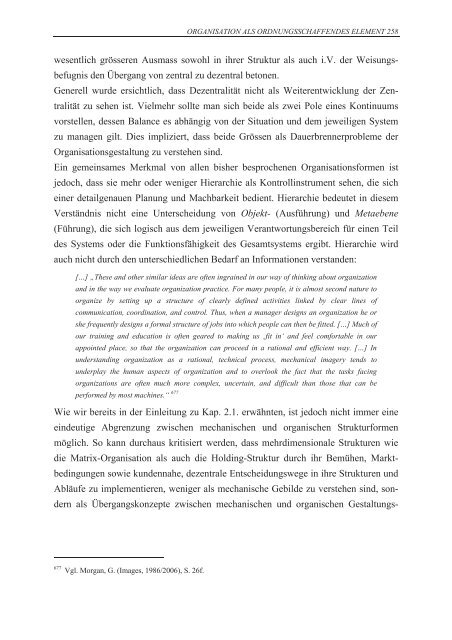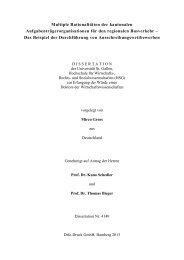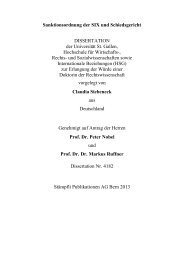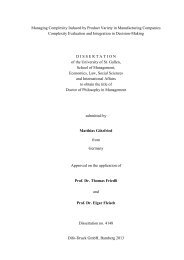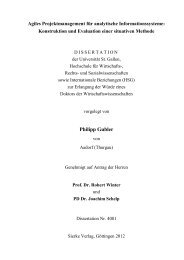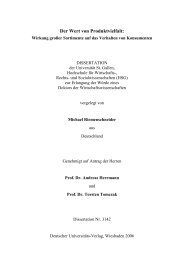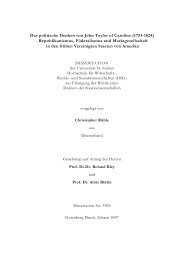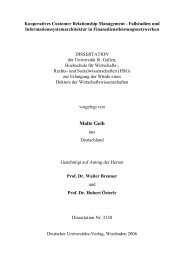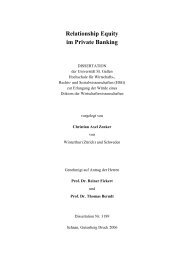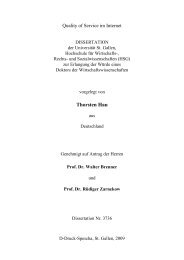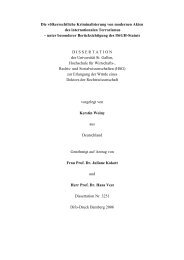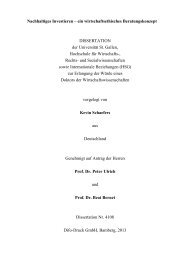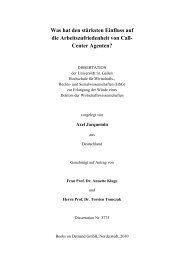- Seite 1 und 2:
Organisation im Wandel Methodologis
- Seite 3 und 4:
DANKSAGUNG III DANKSAGUNG Mit direk
- Seite 5 und 6:
ABBILDUNGSVERZEICHNIS V ABBILDUNGSV
- Seite 7 und 8:
ABKÜRZUNGSVERZEICHNIS VII ABKÜRZU
- Seite 9 und 10:
INHALTSÜBERSICHT IX INHALTSÜBERSI
- Seite 11 und 12:
INHALTSVERZEICHNIS XI 5.3. Modelle
- Seite 13 und 14:
INHALTSVERZEICHNIS XIII 1.1.4. Hera
- Seite 15 und 16:
INHALTSVERZEICHNIS XV IV. ORGANISAT
- Seite 17 und 18:
INHALTSVERZEICHNIS XVII 3.2.5. Syst
- Seite 19 und 20:
SUMMARY 19 SUMMARY The emphasis on
- Seite 21 und 22:
EINLEITUNG 21 der in ihnen tätigen
- Seite 23 und 24:
EINLEITUNG 23 Funktion 15 bedarf es
- Seite 25 und 26:
EINLEITUNG 25 1. Durch das Berücks
- Seite 27 und 28:
EINLEITUNG 27 3. Konzeptionsaufbau
- Seite 29 und 30:
EINLEITUNG 29 Der Inhalt von Kap. 1
- Seite 31 und 32:
EINLEITUNG 31 4. Wissenschaftstheor
- Seite 33 und 34:
EINLEITUNG 33 5. Begriffsverständn
- Seite 35 und 36:
EINLEITUNG 35 eine Menge mehr oder
- Seite 37 und 38:
EINLEITUNG 37 5.2.1. Grundlegendes
- Seite 39 und 40:
EINLEITUNG 39 in systemtheoretisch-
- Seite 41 und 42:
EINLEITUNG 41 5.2.4. Der Umgang mit
- Seite 43 und 44:
EINLEITUNG 43 5.3. Modelle 5.3.1. N
- Seite 45 und 46:
EINLEITUNG 45 Bezugsrahmen des Mode
- Seite 47 und 48:
EINLEITUNG 47 interpretieren, in di
- Seite 49 und 50:
EINLEITUNG 49 Heuristiken können a
- Seite 51 und 52:
EINLEITUNG 51 KAHNEMANN & TVERSKY z
- Seite 53 und 54:
EINLEITUNG 53 recognize more and mo
- Seite 55 und 56:
WANDEL ALS KONSTANTE UNSERER ZEIT 5
- Seite 57 und 58:
WANDEL ALS KONSTANTE UNSERER ZEIT 5
- Seite 59 und 60:
WANDEL ALS KONSTANTE UNSERER ZEIT 5
- Seite 61 und 62:
WANDEL ALS KONSTANTE UNSERER ZEIT 6
- Seite 63 und 64:
WANDEL ALS KONSTANTE UNSERER ZEIT 6
- Seite 65 und 66:
WANDEL ALS KONSTANTE UNSERER ZEIT 6
- Seite 67 und 68:
WANDEL ALS KONSTANTE UNSERER ZEIT 6
- Seite 69 und 70:
WANDEL ALS KONSTANTE UNSERER ZEIT 6
- Seite 71 und 72:
WANDEL ALS KONSTANTE UNSERER ZEIT 7
- Seite 73 und 74:
WANDEL ALS KONSTANTE UNSERERR ZEIT
- Seite 75 und 76:
WANDEL ALS KONSTANTE UNSERER ZEIT 7
- Seite 77 und 78:
WANDEL ALS KONSTANTE UNSERER ZEIT 7
- Seite 79 und 80:
WANDEL ALS KONSTANTE UNSERER ZEIT 7
- Seite 81 und 82:
WANDEL ALS KONSTANTE UNSERER ZEIT 8
- Seite 83 und 84:
WANDEL ALS KONSTANTE UNSERER ZEIT 8
- Seite 85 und 86:
WANDEL ALS KONSTANTE UNSERER ZEIT 8
- Seite 87 und 88:
WANDEL ALS KONSTANTE UNSERER ZEIT 8
- Seite 89 und 90:
WANDEL ALS KONSTANTE UNSERER ZEIT 8
- Seite 91 und 92:
WANDEL ALS KONSTANTE UNSERER ZEIT 9
- Seite 93 und 94:
WANDEL ALS KONSTANTE UNSERER ZEIT 9
- Seite 95 und 96:
WANDEL ALS KONSTANTE UNSERER ZEIT 9
- Seite 97 und 98:
WANDEL ALS KONSTANTE UNSERER ZEIT 9
- Seite 99 und 100:
WANDEL ALS KONSTANTE UNSERER ZEIT 9
- Seite 101 und 102:
WANDEL ALS KONSTANTE UNSERER ZEIT 1
- Seite 103 und 104:
WANDEL ALS KONSTANTE UNSERER ZEIT 1
- Seite 105 und 106:
WANDEL ALS KONSTANTE UNSERER ZEIT 1
- Seite 107 und 108:
WANDEL ALS KONSTANTE UNSERER ZEIT 1
- Seite 109 und 110:
WANDEL ALS KONSTANTE UNSERER ZEIT 1
- Seite 111 und 112:
WANDEL ALS KONSTANTE UNSERER ZEIT 1
- Seite 113 und 114:
WANDEL ALS KONSTANTE UNSERER ZEIT 1
- Seite 115 und 116:
WANDEL ALSS KONSTANTE UNSERER ZEIT
- Seite 117 und 118:
UMFELDDYNAMIK ALS EXTERNER AUSLÖSE
- Seite 119 und 120:
UMFELDDYNAMIK ALS EXTERNER AUSLÖSE
- Seite 121 und 122:
UMFELDDYNAMIK ALS EXTERNER AUSLÖSE
- Seite 123 und 124:
UMFELDDYNAMIK ALS EXTERNER AUSLÖSE
- Seite 125 und 126:
UMFELDDYNAMIK ALS EXTERNER AUSLÖSE
- Seite 127 und 128:
UMFELDDYNAMIK ALS EXTERNER AUSLÖSE
- Seite 129 und 130:
UMFELDDYNAMIK ALS EXTERNER AUSLÖSE
- Seite 131 und 132:
UMFELDDYNAMIK ALS EXTERNER AUSLÖSE
- Seite 133 und 134:
UMFELDDYNAMIK ALS EXTERNER AUSLÖSE
- Seite 135 und 136:
UMFELDDYNAMIK ALS EXTERNER AUSLÖSE
- Seite 137 und 138:
UMFELDDYNAMIK ALS EXTERNER AUSLÖSE
- Seite 139 und 140:
UMFELDDYNAMIK ALS EXTERNER AUSLÖSE
- Seite 141 und 142:
UMFELDDYNAMIK ALS EXTERNER AUSLÖSE
- Seite 143 und 144:
UMFELDDYNAMIK ALS EXTERNER AUSLÖSE
- Seite 145 und 146:
UMFELDDYNAMIK ALS EXTERNER AUSLÖSE
- Seite 147 und 148:
UMFELDDYNAMIK ALS EXTERNER AUSLÖSE
- Seite 149 und 150:
UMFELDDYNAMIK ALS EXTERNER AUSLÖSE
- Seite 151 und 152:
UMFELDDYNAMIK ALS EXTERNER AUSLÖSE
- Seite 153 und 154:
UMFELDDYNAMIK ALS EXTERNER AUSLÖSE
- Seite 155 und 156:
UMFELDDYNAMIK ALS EXTERNER AUSLÖSE
- Seite 157 und 158:
UMFELDDYNAMIK ALS EXTERNER AUSLÖSE
- Seite 159 und 160:
UMFELDDYNAMIK ALS EXTERNER AUSLÖSE
- Seite 161 und 162:
UMFELDDYNAMIK ALS EXTERNER AUSLÖSE
- Seite 163 und 164:
UMFELDDYNAMIK ALS EXTERNER AUSLÖSE
- Seite 165 und 166:
UMFELDDYNAMIK ALS EXTERNER AUSLÖSE
- Seite 167 und 168:
UMFELDDYNAMIK ALS EXTERNER AUSLÖSE
- Seite 169 und 170:
UMFELDDYNAMIK ALS EXTERNER AUSLÖSE
- Seite 171 und 172:
UMFELDDYNAMIK ALS EXTERNER AUSLÖSE
- Seite 173 und 174:
UMFELDDYNAMIK ALS EXTERNER AUSLÖSE
- Seite 175 und 176:
UMFELDDYNAMIK ALS EXTERNER AUSLÖSE
- Seite 177 und 178:
UMFELDDYNAMIK ALS EXTERNER AUSLÖSE
- Seite 179 und 180:
UMFELDDYNAMIK ALS EXTERNER AUSLÖSE
- Seite 181 und 182:
UMFELDDYNAMIK ALS EXTERNER AUSLÖSE
- Seite 183 und 184:
UMFELDDYNAMIK ALS EXTERNER AUSLÖSE
- Seite 185 und 186:
UMFELDDYNAMIK ALS EXTERNER AUSLÖSE
- Seite 187 und 188:
UMFELDDYNAMIK ALS EXTERNER AUSLÖSE
- Seite 189 und 190:
UMFELDDYNAMIK ALS EXTERNER AUSLÖSE
- Seite 191 und 192:
UMFELDDYNAMIK ALS EXTERNER AUSLÖSE
- Seite 193 und 194:
UMFELDDYNAMIK ALS EXTERNER AUSLÖSE
- Seite 195 und 196:
UMFELDDYNAMIK ALS EXTERNER AUSLÖSE
- Seite 197 und 198:
UMFELDDYNAMIK ALS EXTERNER AUSLÖSE
- Seite 199 und 200:
UMFELDDYNAMIK ALS EXTERNER AUSLÖSE
- Seite 201 und 202:
UMFELDDYNAMIK ALS EXTERNER AUSLÖSE
- Seite 203 und 204:
UMFELDDYNAMIK ALS EXTERNER AUSLÖSE
- Seite 205 und 206:
ORGANISATION ALS ORDNUNGSSCHAFFENDE
- Seite 207 und 208: ORGANISATION ALS ORDNUNGSSCHAFFENDE
- Seite 209 und 210: ORGANISATION ALS ORDNUNGSSCHAFFENDE
- Seite 211 und 212: ORGANISATION ALS ORDNUNGSSCHAFFENDE
- Seite 213 und 214: ORGANISATION ALS ORDNUNGSSCHAFFENDE
- Seite 215 und 216: ORGANISATION ALS ORDNUNGSSCHAFFENDE
- Seite 217 und 218: ORGANISATION ALS ORDNUNGSSCHAFFENDE
- Seite 219 und 220: ORGANISATION ALS ORDNUNGSSCHAFFENDE
- Seite 221 und 222: ORGANISATION ALS ORDNUNGSSCHAFFENDE
- Seite 223 und 224: ORGANISATION ALS ORDNUNGSSCHAFFENDE
- Seite 225 und 226: ORGANISATION ALS ORDNUNGSSCHAFFENDE
- Seite 227 und 228: ORGANISATION ALS ORDNUNGSSCHAFFENDE
- Seite 229 und 230: ORGANISATION ALS ORDNUNGSSCHAFFENDE
- Seite 231 und 232: ORGANISATION ALS ORDNUNGSSCHAFFENDE
- Seite 233 und 234: ORGANISATION ALS ORDNUNGSSCHAFFENDE
- Seite 235 und 236: ORGANISATION ALS ORDNUNGSSCHAFFENDE
- Seite 237 und 238: ORGANISATION ALS ORDNUNGSSCHAFFENDE
- Seite 239 und 240: ORGANISATION ALS ORDNUNGSSCHAFFENDE
- Seite 241 und 242: ORGANISATION ALS ORDNUNGSSCHAFFENDE
- Seite 243 und 244: ORGANISATION ALS ORDNUNGSSCHAFFENDE
- Seite 245 und 246: ORGANISATION ALS ORDNUNGSSCHAFFENDE
- Seite 247 und 248: ORGANISATION ALS ORDNUNGSSCHAFFENDE
- Seite 249 und 250: ORGANISATION ALS ORDNUNGSSCHAFFENDE
- Seite 251 und 252: ORGANISATION ALS ORDNUNGSSCHAFFENDE
- Seite 253 und 254: ORGANISATION ALS ORDNUNGSSCHAFFENDE
- Seite 255 und 256: ORGANISATION ALS ORDNUNGSSCHAFFENDE
- Seite 257: ORGANISATION ALS ORDNUNGSSCHAFFENDE
- Seite 261 und 262: ORGANISATION ALS ORDNUNGSSCHAFFENDE
- Seite 263 und 264: ORGANISATION ALS ORDNUNGSSCHAFFENDE
- Seite 265 und 266: ORGANISATION ALS ORDNUNGSSCHAFFENDE
- Seite 267 und 268: ORGANISATION ALS ORDNUNGSSCHAFFENDE
- Seite 269 und 270: ORGANISATION ALS ORDNUNGSSCHAFFENDE
- Seite 271 und 272: ORGANISATION ALS ORDNUNGSSCHAFFENDE
- Seite 273 und 274: ORGANISATION ALS ORDNUNGSSCHAFFENDE
- Seite 275 und 276: ORGANISATION ALS ORDNUNGSSCHAFFENDE
- Seite 277 und 278: ORGANISATION ALS ORDNUNGSSCHAFFENDE
- Seite 279 und 280: ORGANISATION ALS ORDNUNGSSCHAFFENDE
- Seite 281 und 282: ORGANISATION ALS ORDNUNGSSCHAFFENDE
- Seite 283 und 284: ORGANISATION ALS ORDNUNGSSCHAFFENDE
- Seite 285 und 286: ORGANISATION ALS ORDNUNGSSCHAFFENDE
- Seite 287 und 288: ORGANISATION ALS ORDNUNGSSCHAFFENDE
- Seite 289 und 290: ORGANISATION ALS ORDNUNGSSCHAFFENDE
- Seite 291 und 292: ORGANISATION ALS ORDNUNGSSCHAFFENDE
- Seite 293: ORGANISATION ALS ORDNUNGSSCHAFFENDE
- Seite 296 und 297: ORGANISATION ALS ORDNUNGSSCHAFFENDE
- Seite 298 und 299: ORGANISATION ALS ORDNUNGSSCHAFFENDE
- Seite 300 und 301: ORGANISATION ALS ORDNUNGSSCHAFFENDE
- Seite 302 und 303: ORGANISATION ALS ORDNUNGSSCHAFFENDE
- Seite 304 und 305: ORGANISATION ALS ORDNUNGSSCHAFFENDE
- Seite 306 und 307: ORGANISATION ALS ORDNUNGSSCHAFFENDE
- Seite 308 und 309:
ORGANISATION ALS ORDNUNGSSCHAFFENDE
- Seite 310 und 311:
ORGANISATION ALS ORDNUNGSSCHAFFENDE
- Seite 312 und 313:
ORGANISATION ALS ORDNUNGSSCHAFFENDE
- Seite 314 und 315:
ORGANISATION ALS ORDNUNGSSCHAFFENDE
- Seite 316 und 317:
ORGANISATION ALS ORDNUNGSSCHAFFENDE
- Seite 318 und 319:
ORGANISATION ALS ORDNUNGSSCHAFFENDE
- Seite 320 und 321:
ORGANISATION ALS ORDNUNGSSCHAFFENDE
- Seite 322 und 323:
ORGANISATION ALS ORDNUNGSSCHAFFENDE
- Seite 324 und 325:
ORGANISATION ALS ORDNUNGSSCHAFFENDE
- Seite 326 und 327:
ORGANISATION ALS ORDNUNGSSCHAFFENDE
- Seite 328 und 329:
ORGANISATION ALS ORDNUNGSSCHAFFENDE
- Seite 330 und 331:
ORGANISATION ALS ORDNUNGSSCHAFFENDE
- Seite 332 und 333:
ORGANISATION ALS ORDNUNGSSCHAFFENDE
- Seite 334 und 335:
ORGANISATION ALS ORDNUNGSSCHAFFENDE
- Seite 336 und 337:
ORGANISATION ALS ORDNUNGSSCHAFFENDE
- Seite 338 und 339:
ORGANISATION ALS ORDNUNGSSCHAFFENDE
- Seite 340 und 341:
ORGANISATION ALS ORDNUNGSSCHAFFENDE
- Seite 342 und 343:
ORGANISATION ALS ORDNUNGSSCHAFFENDE
- Seite 344 und 345:
ORGANISATION ALS ORDNUNGSSCHAFFENDE
- Seite 346 und 347:
ORGANISATION ALS ORDNUNGSSCHAFFENDE
- Seite 348 und 349:
ORGANISATION ALS ORDNUNGSSCHAFFENDE
- Seite 350 und 351:
ORGANISATION ALS ORDNUNGSSCHAFFENDE
- Seite 352 und 353:
ORGANISATION ALS ORDNUNGSSCHAFFENDE
- Seite 354 und 355:
ORGANISATION ALS ORDNUNGSSCHAFFENDE
- Seite 356 und 357:
ORGANISATION ALS ORDNUNGSSCHAFFENDE
- Seite 358 und 359:
ORGANISATION ALS ORDNUNGSSCHAFFENDE
- Seite 360 und 361:
ORGANISATION ALS ORDNUNGSSCHAFFENDE
- Seite 362 und 363:
ORGANISATION ALS ORDNUNGSSCHAFFENDE
- Seite 364 und 365:
ORGANISATION ALS ORDNUNGSSCHAFFENDE
- Seite 366 und 367:
ORGANISATION ALS ORDNUNGSSCHAFFENDE
- Seite 368 und 369:
ORGANISATION ALS ORDNUNGSSCHAFFENDE
- Seite 370 und 371:
ORGANISATION ALS ORDNUNGSSCHAFFENDE
- Seite 372 und 373:
ORGANISATION ALS ORDNUNGSSCHAFFENDE
- Seite 374 und 375:
DAS NIA-PROZESSMODELL GEPLANTER ORG
- Seite 376 und 377:
DAS NIA-PROZESSMODELL GEPLANTER ORG
- Seite 378 und 379:
DAS NIA-PROZESSMODELL GEPLANTER ORG
- Seite 380 und 381:
DAS NIA-PROZESSMODELL GEPLANTER ORG
- Seite 382 und 383:
DAS NIA-PROZESSMODELL GEPLANTER ORG
- Seite 384 und 385:
DAS NIA-PROZESSMODELL GEPLANTER ORG
- Seite 386 und 387:
DAS NIA-PROZESSMODELL GEPLANTER ORG
- Seite 388 und 389:
FAZIT UND AUSBLICK 388 VI. FAZIT UN
- Seite 390 und 391:
FAZIT UND AUSBLICK 390 sprüche i.V
- Seite 392 und 393:
FAZIT UND AUSBLICK 392 Einen ersten
- Seite 394 und 395:
FAZIT UND AUSBLICK 394 Wissen in de
- Seite 396 und 397:
ANHANG 396 VII. Anh. 1: Anh. 2: A
- Seite 398 und 399:
ANHANG 398 ANHANG II Anh. 2: Zeitli
- Seite 400 und 401:
ANHANG 400 ANHANG IV und V Some org
- Seite 402 und 403:
ANHANG 402 ANHANG VII Anh. 7: Das k
- Seite 404 und 405:
LITERATURVERZEICHNIS 404 LITERATURV
- Seite 406 und 407:
LITERATURVERZEICHNIS 406 Beinhocker
- Seite 408 und 409:
LITERATURVERZEICHNIS 408 Burns, T.
- Seite 410 und 411:
LITERATURVERZEICHNIS 410 Brunswick/
- Seite 412 und 413:
LITERATURVERZEICHNIS 412 a.M/Berlin
- Seite 414 und 415:
LITERATURVERZEICHNIS 414 Psychologi
- Seite 416 und 417:
LITERATURVERZEICHNIS 416 Hedberg, B
- Seite 418 und 419:
LITERATURVERZEICHNIS 418 analyses -
- Seite 420 und 421:
LITERATURVERZEICHNIS 420 Frühaufkl
- Seite 422 und 423:
LITERATURVERZEICHNIS 422 Stuttgart:
- Seite 424 und 425:
LITERATURVERZEICHNIS 424 McKendall,
- Seite 426 und 427:
LITERATURVERZEICHNIS 426 Stuttgart:
- Seite 428 und 429:
LITERATURVERZEICHNIS 428 (1. Ed.).
- Seite 430 und 431:
LITERATURVERZEICHNIS 430 Bergisch G
- Seite 432 und 433:
LITERATURVERZEICHNIS 432 Smith, K.
- Seite 434 und 435:
LITERATURVERZEICHNIS 434 Ulrich, H.
- Seite 436 und 437:
LITERATURVERZEICHNIS 436 Jossey Bas
- Seite 438 und 439:
LITERATURVERZEICHNIS 438 Jr., C. H.


